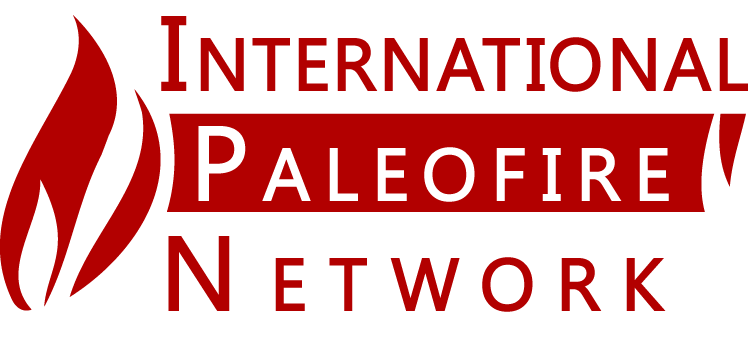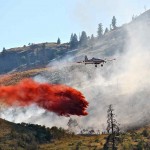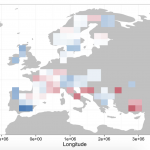Levels of biomass burning in parts of the world are now higher than at any time in the past 22,000 years, according to our most recent fire history reconstructions from the Global Charcoal Database version 3 (GCDv3), just published today in Biogeosciences. Biomass burning from the Last Glacial Maximum, about 21,000 years ago, through the late Holocene (up until about 200 years ago), broadly tracks global and regional climate changes. In the past millennium (Fig. 1), a widespread decline in fire activity is clear during the “Little Ice Age” (LIA, ~1600s – 1700s CE) in both hemispheres, but is more pronounced in the north. Biomass burning increases gradually from about 1600-1800 CE, then rapidly increases in both hemispheres during the 1800s. After that, charcoal levels start to decline first in the northern hemisphere, then in the southern hemisphere, reaching very low levels during the 20th century. The marked decline in global biomass burning during the 20th century was the focus of a previous paper, which attributed it to a confluence of factors including the rapid spread of agriculture, landscape fragmentation, increased grazing, and eventually industrial-strength fire suppression. Now however, thanks to longer fire seasons and hotter temperatures from global warming, along with fuel build-up in many places, strong regional increases in biomass burning are on the rise again, particularly in western North America and southeastern Australia.
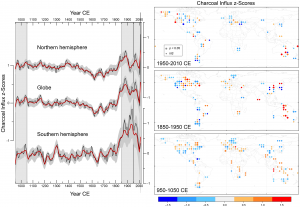
Figure 1. Trends in biomass burning (left panel) for the Northern Hemisphere, globe, and Southern Hemisphere for the past 1000 years and spatially gridded charcoal influx z scores reflecting biomass burning (right panel) for the period 1950–2010, 1850–1950, and 950–1050 CE. Vertical gray bars through the time series on the left panel correspond to the time intervals shown in the gridded dot maps on the right panel. The charcoal influx anomaly base period for all panels is 1000–1800 CE. The smoothing window widths for the time series (left panel) are 40 years (red line) and 20 years (black line). Bootstrap-by-site confidence intervals (95 %) are filled in gray.
The paper, Reconstructions of biomass burning from sediment-charcoal records to improve data–model comparisons, which was initiated at a PAGES Global Paleaofire Working Group workshop in France in 2013, analyzes 736 charcoal records from six continents (Fig. 2), but primarily represents burning in forests, rather than grasslands. The biomass burning reconstructions are largely based on variations in charcoal accumulation rates in sediment cores from lakes, but records from bogs, marine sediments, and other environments are included. The paper also presents a new approach for gridding charcoal data using the paleofire R package (Blarquez et al. 2014), which is designed to allow easier comparison between the data and model output.
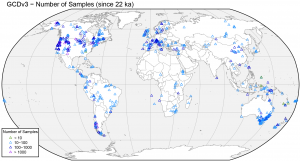
Figure 2. Location of paleofire sites and sampling density in the GCDv3.
For pictures and video you may want to check out Youtube — there is pretty cool (sorry) special called “Earth on Fire” about the spread of the new “megafires.”
Citation: Marlon, J. R., Kelly, R., Daniau, A.-L., Vannière, B., Power, M. J., Bartlein, P., Higuera, P., Blarquez, O., Brewer, S., Brücher, T., Feurdean, A., Romera, G. G., Iglesias, V., Maezumi, S. Y., Magi, B., Courtney Mustaphi, C. J., and Zhihai, T.: Reconstructions of biomass burning from sediment-charcoal records to improve data–model comparisons, Biogeosciences, 13, 3225-3244, doi:10.5194/bg-13-3225-2016, 2016.
